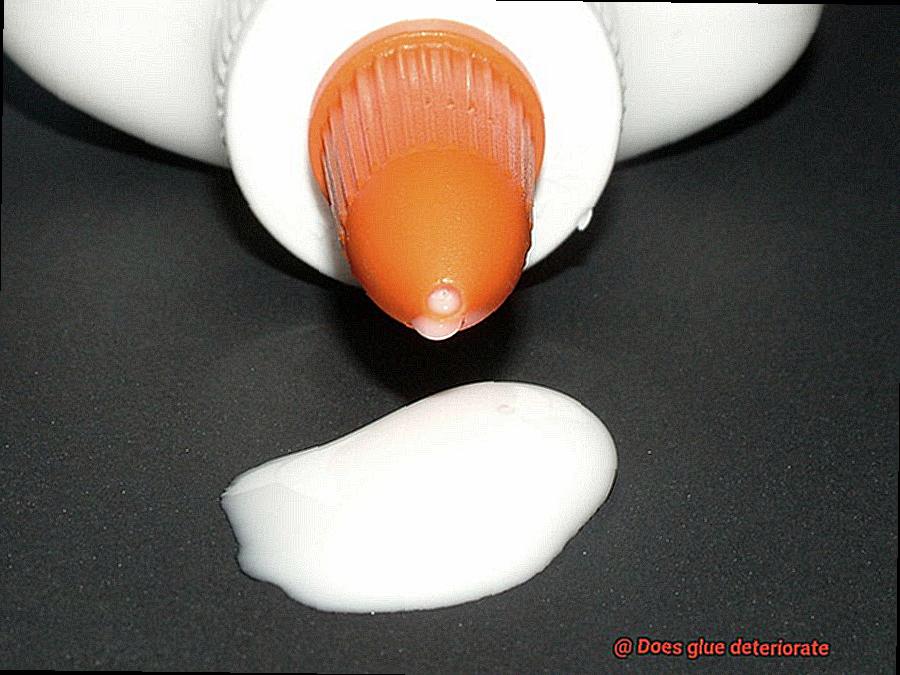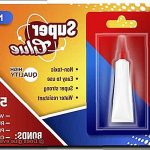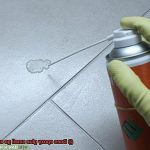Have you ever relied on glue to fix a broken item, only to wonder if the bond it creates is permanent or temporary? If so, you’re not alone. Glue has been a lifesaver for many of us, but does it deteriorate over time? As an expert on all things adhesive, I’m excited to take you on a journey through the science behind glue deterioration.
It’s important to note that most glues are made of organic materials, and as we know, organic materials decay over time. But what determines the rate at which glue deteriorates? Well, that depends on various factors such as the type of glue used and the storage conditions. In this blog post, we’ll be exploring these factors in-depth to answer the question – does glue deteriorate?
But that’s not all. We’ll also be examining how long-term glue deterioration affects bonded objects and critical items. And don’t worry – I won’t leave you hanging without solutions. We’ll discuss how to extend your glue’s lifespan by storing it under optimal conditions and how to identify deteriorating glue before it causes any unintended consequences.
So, join me in this fascinating exploration of the world of glue deterioration. Buckle up and get ready for some sticky science.
Types of Glue: Cyanoacrylate (Super Glue) vs Polyurethane-Based Adhesives
Contents
- 1 Types of Glue: Cyanoacrylate (Super Glue) vs Polyurethane-Based Adhesives
- 2 Storage Conditions: Heat, Humidity, and Direct Sunlight
- 3 Effect of Exposure to Air on Glue
- 4 Impact of Thickness when Applying Glue
- 5 Effects of Movement and Vibration on Glue
- 6 Ways to Extend the Lifespan of Glue
- 7 Common Mistakes People Make When Using Glue
- 8 Conclusion
There are many types of glue available, but two of the most popular options are cyanoacrylate (super glue) and polyurethane-based adhesives. These two types of glue have their own unique properties and uses, but how do they differ in terms of their durability and lifespan? Let’s take a closer look.
Cyanoacrylate (super glue) is a fast-drying adhesive that forms a strong bond between surfaces. However, it can start to deteriorate within months if not stored properly. Exposure to heat and light can also cause it to deteriorate faster, making it less effective over time.
Polyurethane-based adhesives, on the other hand, are known for their durability and strength. They form a strong bond that can withstand changes in temperature and humidity. Unlike super glue, polyurethane-based adhesives do not dry out and become brittle over time. They can last for years if stored in a cool, dry place and kept tightly sealed.
While super glue may be more suitable for smaller projects that require quick bonding, polyurethane-based adhesives may be more suitable for larger projects that require strength and durability.
It is important to choose the right type of glue based on the specific needs of the project. For example, if the project will be exposed to heat or light, polyurethane-based adhesives may be the better choice. If the project requires quick bonding, super glue may be more suitable.
Proper storage and usage can help prolong the lifespan of both cyanoacrylate and polyurethane-based adhesives. Make sure to store them in a cool, dry place and keep them tightly sealed when not in use.
In conclusion, both cyanoacrylate (super glue) and polyurethane-based adhesives have their own strengths and weaknesses when it comes to deterioration over time. It ultimately depends on the specific use and conditions in which the glue will be exposed to over time.
Storage Conditions: Heat, Humidity, and Direct Sunlight
The culprit might be the storage conditions. Heat, humidity, and direct sunlight can significantly impact the lifespan of glue.
Let’s start with heat – the enemy of all things adhesive. Exposure to high temperatures can turn glue runny, causing it to lose its adhesive properties and break down. To prevent this from happening, store your glue in a cool and dry place far away from any sources of heat, like radiators or direct sunlight.
Next up is humidity. When exposed to moisture or high levels of humidity, glue can become weak and lose its adhesive properties. Water molecules in the air react with the chemicals in the glue, causing it to break down and become ineffective. To prevent this, store your glue in an airtight container or bag in a dry place.
Lastly, direct sunlight can be detrimental to your glue. UV rays from the sun break down chemical bonds in glue, causing it to lose its adhesive properties and become brittle. Keep your glue away from any sources of direct sunlight by storing it in a dark place.
Effect of Exposure to Air on Glue
Glue is the unsung hero of various applications, from woodworking to construction and arts and crafts. It creates a strong and durable bond between surfaces, making it an indispensable tool for DIY enthusiasts and professionals alike. But did you know that exposure to air can significantly impact the quality of glue over time?
The science behind this phenomenon is fascinating. Glue works by bonding two surfaces together, but when exposed to air, it can dry out and become brittle. As a result, it loses its bonding strength and fails to hold surfaces together. The rate at which glue deteriorates depends on various factors such as the type of glue, humidity levels, temperature, and duration of exposure to air.
For instance, PVA glue (polyvinyl acetate) is commonly used in woodworking projects and has good resistance to water. However, leaving it exposed to air for an extended period can result in a skin forming on the surface, preventing it from bonding effectively. On the other hand, cyanoacrylate glue (super glue) can dry out quickly when exposed to air and become less effective.
To prevent your glue from deteriorating when exposed to air, proper storage is essential. First and foremost, keep your glue in an airtight container when not in use to prevent moisture from entering and drying out the glue. Moreover, always use fresh glue for each project rather than reusing old or expired glue.
Impact of Thickness when Applying Glue
Understanding how thickness impacts the bond strength and drying time of glue is essential for achieving long-lasting results in your DIY projects.
In general, thinner layers of glue are more effective than thicker ones. Thicker layers take longer to dry, and the excess adhesive can lead to uneven drying or air pockets that weaken the bond. Therefore, for a strong and quick-drying bond, it’s best to apply a thin and even layer of glue.
Exceptions:
Despite the above, there are certain situations where thicker layers of glue may be necessary or desirable. For example, when bonding two porous surfaces together, a thicker layer of glue can fill in gaps and irregularities in the surface, resulting in a stronger bond. Additionally, some types of adhesives such as construction adhesives used for heavy-duty bonding applications are designed to be applied in thicker layers.
Manufacturer’s Instructions:
To avoid any mishaps, it’s crucial to follow the manufacturer’s instructions regarding the recommended thickness of the adhesive layer. Applying glue according to instructions ensures that it bonds effectively and dries properly.
Factors Affecting Drying Time:
Temperature and humidity can significantly impact how quickly glue dries and how strong the bond will be. Therefore, it’s important to work in ideal conditions when applying glue to ensure optimal results. Using too much or too little glue can also affect the strength of the bond and should be avoided.
Effects of Movement and Vibration on Glue
These factors can have a significant impact on the durability of your projects and should not be overlooked.
Let’s dive into the effects of movement on glue bonds. When an object bonded with glue is moved, it can cause stress on the bond, leading to weakening or even breakage over time. For instance, if you drag a chair glued together with wood glue instead of lifting it, you risk putting unnecessary strain on the bond between the pieces. This can result in a wobbly chair or, worse still, a potentially hazardous situation if the bond completely fails.

Vibration is another factor that can compromise the strength of your glued structures. Over time, constant vibrations can gradually weaken the bond created by glue, causing it to break down. For example, if you place a glued object near a vibrating machine such as a washing machine or dryer, the continuous shaking can cause the bond to deteriorate until it eventually fails.
To ensure that your glued structures remain strong and durable, it’s crucial to be mindful of movement and vibration when working with glue. By avoiding dragging or stressing glued objects and keeping them away from sources of constant vibration, you can help prevent weakening or breakage of the bond created by glue.
Ways to Extend the Lifespan of Glue
Glue is a versatile adhesive that is used in various industries such as woodworking, construction, and crafting. However, it can be frustrating when glue dries out too quickly or loses its adhesive strength. To get the most out of your glue and extend its lifespan, here are five tips to consider:
Proper Storage
The first step in extending the lifespan of your glue is proper storage. Store it in a cool, dry place away from direct sunlight and heat sources. This will prevent the glue from breaking down and becoming too thick or runny. Also, make sure to keep the container upright to avoid any spills or leaks.
Seal the Container
When not in use, ensure that the container is tightly sealed to prevent air from entering. Air exposure can cause the glue to dry out and become unusable. Glue with applicator tips can help reduce air exposure and make it easier to apply.
Clean Tools
Before using glue, ensure that your tools are clean. Any dirt or debris can contaminate the glue and affect its effectiveness. Clean your tools thoroughly after each use to prevent contamination.
Use Fresh Glue
Check the expiration date of your glue before using it. Using expired glue can lead to weak bonds and even complete failure. It’s better to invest in a new bottle of glue than risk ruining your project.
Follow Manufacturer’s Instructions
Lastly, following the manufacturer’s instructions can help ensure that your glue remains effective for an extended period. Manufacturers often provide specific instructions on how to store their products and for how long they are safe to use. It is important to follow these instructions to avoid any issues with the glue’s adhesive properties.
Common Mistakes People Make When Using Glue
Glue is a versatile tool that can help us fix or create almost anything. But, it’s not just about applying glue and hoping for the best. There are some common mistakes people make when using glue that can lead to a weak bond, causing deterioration over time.
One of the most common mistakes people make is not preparing the surface before applying the glue. If the surface is not clean and dry, the glue may not adhere properly, leading to a weak bond that can deteriorate over time. So, always ensure that the surface is free from dirt and moisture before applying any glue.
Another mistake people make is using too much or too little glue. Using too much glue can create excess moisture, which can weaken the bond over time. On the other hand, using too little glue can result in a weak bond that may deteriorate over time as well. To avoid this mistake, it’s essential to follow the manufacturer’s instructions and use the recommended amount of glue for the project.
Using the wrong type of glue for a particular project is also a common mistake. Different types of glue are designed for different materials, and using the wrong type of glue can lead to deterioration of the bond over time. For example, if you use a wood glue on metal, the bond may weaken and deteriorate quickly. So, always choose the right type of glue for your project.
Lastly, not allowing enough time for the glue to dry and cure properly is another common mistake. Rushing to use or handle an item before the glue has fully cured can cause the bond to weaken and deteriorate over time. It’s important to follow the manufacturer’s instructions and allow enough time for the glue to dry and cure before handling the item.
1hY1jyGNzIo” >
Conclusion
To sum up, glue is a jack-of-all-trades when it comes to fixing and creating things. But let’s face it, nothing lasts forever, and neither does glue. The lifespan of glue depends on various factors such as the type of adhesive used and the storage conditions. For instance, super glue can bond surfaces in seconds but can start to deteriorate within months if not kept in optimal conditions. On the other hand, polyurethane-based adhesives are known for their robustness and longevity and can last for years if stored correctly.
Proper storage is key to extending the life of your glue. Keep it in a cool, dry place away from direct sunlight and heat sources and seal it tightly when not in use to prevent air exposure. Additionally, adhering to the manufacturer’s instructions on usage and expiration dates will ensure optimal results.
Avoiding common mistakes when using glue can also help you achieve long-lasting results. These include prepping the surface before applying the adhesive, using just enough (or too little) glue, selecting the right type of glue for your project, and allowing sufficient time for drying and curing.
By taking these factors into account and avoiding pitfalls when using glue, you’ll be able to tackle any DIY project with confidence.






